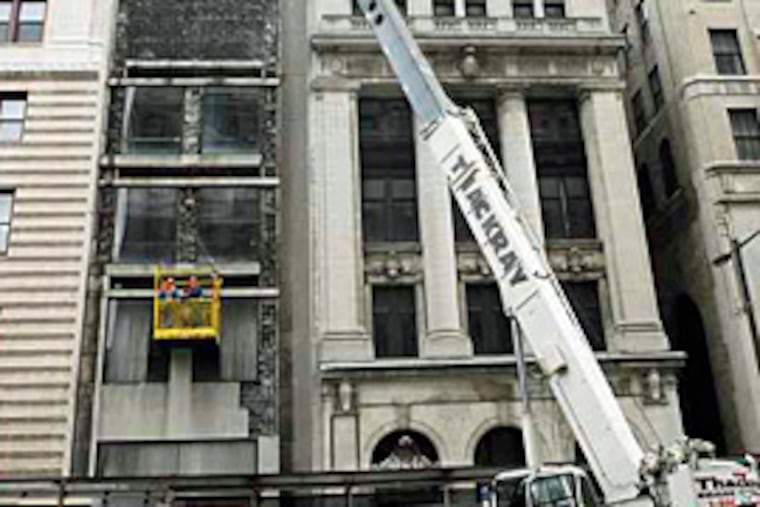Judge: Pa. may defy deal, raze buildings
He said the state historical commission, which won a Convention Center vow to protect, could only advise.

A judge in Harrisburg yesterday cleared the way for the state to demolish two historic buildings on North Broad Street that the Pennsylvania Convention Center Authority had formally pledged to save and weave into the center's prominent new facade.
The written opinion, issued late yesterday afternoon by Commonwealth Court Judge Keith B. Quigley, effectively lifted a stop-work order in place since Christmas Eve and allowed the state to start taking down the structures immediately.
"They could be gone by morning," said a dismayed John Gallery, who heads the Preservation Alliance of Greater Philadelphia, the nonprofit group that led the legal challenge against demolition. Last night, the group had not yet determined whether it would appeal Quigley's ruling to the state Supreme Court or seek a second injunction.
Gallery added that the decision could have serious implications for historic preservation in Pennsylvania. Quigley's ruling effectively reduces the state's top preservation agency, the Historical and Museum Commission, to a toothless advisory body.
Preservationists were under the impression that the Broad Street buildings had been saved in 2004 because the historical commission brokered a landmark agreement with the Convention Center Authority.
Convention Center officials pledged to preserve the two midblock structures and make them part of an expanded center's new facade. Once the headquarters for the Philadelphia Life Insurance Co., the buildings are part of an intact row that frames the north side of City Hall and demonstrates how Philadelphia's commercial architecture evolved.
In exchange for sparing the linked pair - one building a petite 1915 neoclassical temple, the other a 1962 addition by renowned Philadelphia School architect Romaldo Giurgola - the state historical commission agreed to sacrifice several other noteworthy historic buildings in the expansion zone.
But as work on the $700 million project began last summer, the state agency enlarging the Convention Center - the Department of General Services - abruptly announced that it would override the agreement and raze the Broad Street structures.
The DGS said the buildings, between Arch and Cherry Streets, were structurally unsound and would require millions of dollars to fix. Others, however, saw the sudden reversal as an attempt by the Rendell administration to remove a bothersome obligation from the Convention Center project.
Yesterday, Quigley gave the DGS full backing. Under Pennsylvania's history code, he wrote, the department was merely required to "consult" with the historical commission, which it did.
After the ruling, department spokesman Edward Myslewicz issued a statement applauding the judge's reasoning. The opinion "reaffirms our consistent position that the DGS acted well within the law and in good faith," the statement said.
"In addition to public safety," it continued, "we acted responsibly to control costs and to protect taxpayer dollars."
During the last several weeks of legal maneuvers, the historical commission stood on a sideline while the Preservation Alliance argued in its defense. Quigley had initially intended to hold a full trial this week, but decided to issue a ruling based on briefs the two sides filed.
Preservationists argued that because of the signed agreement with the Convention Center Authority, this case wasn't just about the powers of the state historical commission. In their view, the DGS action was tantamount to breaking a contract. But Quigley also disagreed on that point.
He wrote that the "memorandum of agreement" was not the same as a binding contract. The authority was in no position to make the deal, Quigley concluded, because it is only the center's operator, not its owner.
Alan Greenberger, who heads the Design Advocacy Group, which also campaigned to save the Broad Street buildings, said he was disturbed that the issue had been decided on narrow legal arguments rather than the historic worth of the structures.
"If the state now proceeds with demolition, it will be because it chose to follow a technical, legalistic court decision," Greenberger said. "It's very discouraging that DGS can't bring itself to rise to the occasion and do the right thing."
Even if nothing can be done to save the block, Gallery said, there is now a strong argument to review the state's history code.
"The state history code should be something that has more teeth," he argued. "There are going to be other state projects that impact important historic buildings. We have an interest in making the state history code as good as it can be."